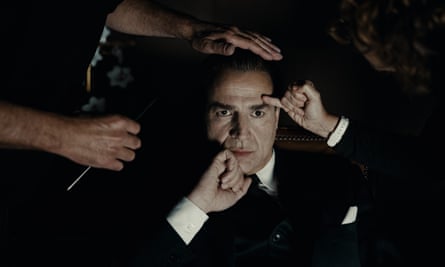‘Fashion isn’t what it used to be,” a journalist purrs at a couturier outside the funeral of Coco Chanel in the opening minutes of Disney+’s latest biographical series. And in the case of the couturier in question, Cristóbal Balenciaga, it really isn’t.
Balenciaga was a highly innovative and influential figure in the world of fashion, who was praised by Chanel as “a true couturier.” His dedication to craftsmanship earned him the title of “The Master” of fashion, even during the chaotic mid-20th century. However, in present times, the brand has strayed from its roots and is now primarily associated with cheaply made sneakers and oversized sweaters worn by reality TV stars. As depicted in the program, Balenciaga was always a visionary artist pushing the boundaries of design. But with marketing campaigns featuring cartoon characters, teddy bears in bondage gear, expensive leather trash bags, and towels worn as skirts, it is clear that the subject of this series would be appalled by what his name has become associated with.
The story follows Balenciaga as he shares his experiences with journalist Prudence Glynn (played by Gemma Whelan) in a rare interview. It focuses on the years he spent in Paris, some of which were during Nazi occupation. As a closeted gay man, he faced extra challenges during this time, but his business partner reminds him that things are not better in Spain. In the midst of turmoil, Balenciaga must decide what is worth fighting for and if his art has a place in such widespread suffering. Despite personal and global losses, he believes that his work and efforts to make the world more beautiful one garment at a time are worthwhile.

Compared to other shows, it lacks the intense drama and violent plot twists found in House of Gucci or American Crime Story: The Assassination of Gianni Versace. While Balenciaga’s life was marked by tragedy, the show explores how this impacted his creative process. During times of mourning, he would design collections entirely in black. This is fitting for a designer who was meticulous about every detail and construction of his garments, often imperceptible to anyone but himself. The clothing itself takes on a central role in the show. In addition to Alberto San Juan’s elegant portrayal of the man himself, the complexity of sleeves is given significant screen time.
Befitting its subject the series is also utterly gorgeous, lit with sensuous golden glows and shallow focus that picks out the period details in the architecture, clothes and passive-aggressive dynamics between Balenciaga’s many rivals.
The series culminates in the 1960s, when Balenciaga gained recognition for dressing royalty and his designs reached their peak of innovation. He was known for creating jackets from a single piece of fabric and crafting avant-garde, sculptural pieces that still elicit awe on the runway. However, there was pressure for him to shift towards ready-to-wear fashion and move away from custom couture, which went against his beliefs. Balenciaga, a man who saw beauty in even the smallest pleat, experienced both love and loss throughout the decades. His dedication to his craft was so strong that he found it easier to cope with the loss of a loved one than the growing popularity of polyester.
The tone of the show is sophisticated and serious, showing great respect for the subject and his life’s accomplishments. The only moment of humor comes when the show acknowledges the current state of affairs. Uncertain about the future of his fashion house, he contemplates shutting it down and confides in his trusted friend Ramón (Adam Quintero) about his fears, stating: “I’m afraid that Maison Balenciaga cannot continue without me. What sense would that make?” When Ramón suggests that “Yves Saint Laurent took over after Dior,” Balenciaga’s face drains of color and he angrily exclaims, “I have always found that repulsive. How could someone sign with my name?”
To watch this series, and get wrapped up in the beauty, craft and dignity of Balenciaga’s life’s work feels luxurious in itself, as it’s created with a care that befits its legendary subject. He was a man who cared little for the spotlight or personal fame, so this non-salacious look at his pursuit of excellence rather than his inner turmoil is a seamless extension of his legacy.
Ignore the advertisement for the newsletter.
after newsletter promotion
Always at the forefront of innovation, it’s unclear what Balenciaga, who died in 1972, would have thought of Kim Kardashian being wrapped head to toe in yellow caution tape printed with his name. He may have admired the pushing of boundaries that his name came to represent. But watching this artist at work across six episodes and 30 years, your heart can’t help but break a little that Balenciaga isn’t what it used to be.
Source: theguardian.com
